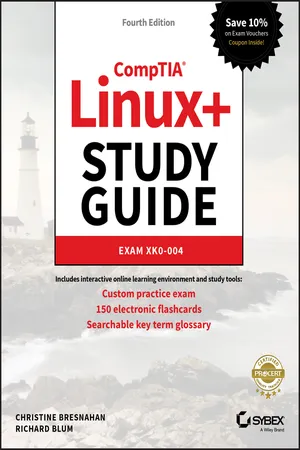
- English
- ePUB (mobile friendly)
- Available on iOS & Android
About this book
The bestselling study guide completely updated for the NEW CompTIA Linux+ Exam XK0-004
This is your one-stop resource for complete coverage of Exam XK0-004, covering 100% of all exam objectives. You'll prepare for the exam smarter and faster with Sybex thanks to superior content including, assessment tests that check exam readiness, objective map, real-world scenarios, hands-on exercises, key topic exam essentials, and challenging chapter review questions.
Linux is a UNIX-basedoperating systemoriginally created by Linus Torvalds with the help of developers around the world. Developed under the GNU General Public License, the source code is free. Because of this Linuxis viewed by many organizations and companies as anexcellent, low-cost, secure alternative to expensive OSs, such as Microsoft Windows. The CompTIALinux+ examtests a candidate's understanding and familiarity with the Linux Kernel. As the Linux server market share continues to grow, so too doesdemand for qualified and certified Linux administrators.
Building on the popular Sybex Study Guide approach, this book will provide 100% coverage of the NEW Linux+ ExamXK0-004 objectives.The book contains clear and concise information onall Linux administrationtopic, and includes practical examples and insights drawn from real-world experience.
- Hardware and System Configuration
- Systems Operation and Maintenance
- Security
- Linux Troubleshooting and Diagnostics
- Automation and Scripting
You'll alsohave access to an online test bank, including a bonus practice exam, electronic flashcards, and a searchable PDF of key terms.
Frequently asked questions
- Essential is ideal for learners and professionals who enjoy exploring a wide range of subjects. Access the Essential Library with 800,000+ trusted titles and best-sellers across business, personal growth, and the humanities. Includes unlimited reading time and Standard Read Aloud voice.
- Complete: Perfect for advanced learners and researchers needing full, unrestricted access. Unlock 1.4M+ books across hundreds of subjects, including academic and specialized titles. The Complete Plan also includes advanced features like Premium Read Aloud and Research Assistant.
Please note we cannot support devices running on iOS 13 and Android 7 or earlier. Learn more about using the app.
Information
PART I
Gathering Your Tools
Chapter 1
Preparing Your Environment

Setting Up a Learning Space
Using That Old Laptop
| Resource | Minimum | Recommended |
| Memory | 2GB | >= 4GB |
| Free disk space | 25GB | >= 30GB |
| Processor | 2GHz dual core | > 2GHz dual core |
Table of contents
- Cover
- Title Page
- Copyright
- Acknowledgments
- About the Authors
- Introduction
- Part I Gathering Your Tools
- Part II Starting Up and Configuring Your System
- Part III Managing Your System
- Part IV Securing Your System
- Part V Troubleshooting Your System
- Part VI Automating Your System
- Part VII Realizing Virtual and Cloud Environments
- Wiley End User License Agreement